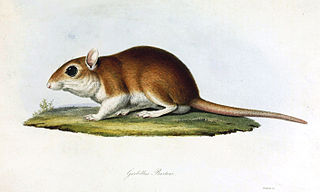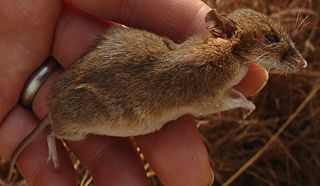The Berbera gerbil is distributed mainly in Somalia, but its range may extend into Ethiopia and Djibouti. It is endemic to the Ethiopian xeric grasslands and shrublands ecoregion.
Lowe's gerbil is distributed mainly in Sudan; Jebel Marra. Less than 250 individuals of this species are thought to persist in the wild.
The Somalian gerbil is found only in Somalia.
The Khartoum gerbil is found mainly in Sudan.
James's gerbil is a species of rodent endemic to the eastern coast of Tunisia.
The pleasant gerbil is a species of rodent found mainly in Libya and Egypt, and possibly Mauritania to Tunisia. This species is about 6 cm in body length, with a brown agouti-style coat, a white belly and a very long tail. It is also known as the charming dipodil.
Brockman's gerbil is distributed mainly in Somaliland and is only known from the type locality, Burao in central Somaliland.
Grobben's gerbil is a species of rodent, distributed mainly in Libya; Cyrenaica, Dernah. Less than 250 individuals of this species are thought to persist in the wild. It is named after Austrian biologist Karl Grobben.
The principal gerbil is a species of gerbil distributed mainly in Sudan; Jebel Meidob; El Malha. Fewer than 250 individuals of this species are thought to persist in the wild.

Waters's gerbil is distributed mainly in Sudan, Somalia, and Djibouti.
The pygmy gerbil is distributed mainly in Algeria to Israel and the Arabian Peninsula. It is also known as Henley's gerbil or pygmy dipodil. Gerbillus henleyi is a long-tailed small gerbil with a back coat that is dark grey-brown which has specific white spots, and the species has small upper molars. Gerbillus henleyi, like other species of the Genus Gerbillus, forage nocturnally and have mainly a plant based diet, and also depend on those dietary items for energy and water.
The least gerbil is distributed mainly in South Sudan, southwestern Ethiopia, Kenya, and Tanzania.

Burton's gerbil is distributed mainly in Darfur, Sudan. Less than 250 individuals of this species of rodent are thought to persist in the wild. It may have been named after Edward Burton, who had the gerbil in his menagerie, obtained from Darfur and described by Frédéric Cuvier.

The pale gerbil(Gerbillus perpallidus) is endemic to Egypt and is distributed mainly in the northwestern part of the country. It is also known as the pallid gerbil. The pale gerbil has pale orange fur, with white underparts, white forelimbs and white feet. The ears are unpigmented and the soles of the feet are haired, which is a characteristic of sand-dwelling gerbils.
The occidental gerbil is distributed mainly southwestern Morocco. Less than 250 individuals of this species are thought to persist in the wild.
The Rosalinda gerbil is distributed mainly central Sudan.
The Agag gerbil is distributed mainly in southern Mauritania to northern Nigeria and Sudan. IUCN lists the junior synonyms Gerbillus cosensi and G. dalloni as critically endangered.
The Sudan gerbil is distributed mainly in central Sudan.

Rudd's mouse or the white-bellied brush-furred rat is the only member of the genus Uranomys. This animal is closely related to the spiny mice, brush-furred mice, and the link rat.
The rupicolous gerbil is a species of rodent in the family Muridae. It is found only in Mali. Its natural habitats are dry savanna and rocky areas.




